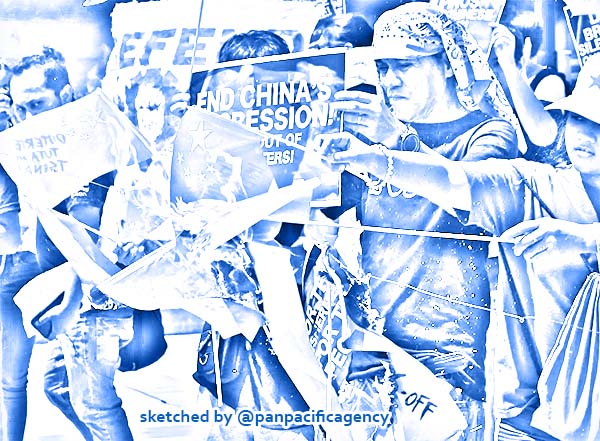[Analytics] China’s drive for hegemony meets resistance

Activists burn Chinese flags and display anti-China placards during a protest at a park in Manila on June 18, 2019, after a Chinese ship collided with a Philippine fishing vessel, which sank in the disputed South China Sea. Such Chinese behavior has been adding up. Photo: AFP / Ted Aljibe. Sketched by the Pan Pacific Agency.
It’s an odd sort of great power rivalry: China and the US competing to see which can alienate more of their potential partners and allies. In the Indo-Pacific, recent diplomatic and economic developments indicate that China is starting to “win” this contest. Scott Foster specially for the Asia Times.
On June 4, India and Australia announced a “Comprehensive Strategic Partnership,” a “Shared Vision for Maritime Cooperation in the Indo-Pacific” and a “Mutual Logistics Support Agreemen” to increase their military inter-operability. They didn’t need to explain why.
This raises the possibility of Australia rejoining the annual Malabar naval exercises which for the past six years have been held by India, the US and Japan. Australia last participated in 2007.
If Australia does rejoin, that would add a military aspect to the Quadrilateral Security Dialogue initiated by Japanese Prime Minister Abe in 2007 – even if Australian diplomats continue to maintain that “the Quad” is simply a consultation mechanism.
Earlier this year, Australia’s outgoing high commissioner to India, Harinder Sidhu, said that, if there’s an invitation to rejoin the Malabar exercises, “Australia will happily participate.”
India and Australia’s Shared Vision includes the statement: “India and Australia have an enduring interest in a free, open, inclusive and rules-based Indo-Pacific region. They have a shared interest in ensuring freedom of navigation and overflight in the Indo-Pacific region, and maintaining open, safe and efficient sea lanes for transportation and communication.”
That alone is a rebuke to China.
Two days earlier, on June 2, Philippine President Rodrigo Duterte suspended the abrogation of the Philippines-United States Visiting Forces Agreement (VFA), which allows and governs the presence of U.S. military personnel in the Philippines,
Infuriated yet again by high-handed American diplomatic moralizing, Duterte had notified the US Embassy that the VFA would be terminated on August 9. But the termination date has now been pushed out six months, with another six-month extension possible, and the abrogation of the abrogation increasingly likely.
China has promised a lot to the Philippines but delivered mainly encroachment on its territorial waters and those of other members of ASEAN. Even Duterte, a man who has been angry with the United States for decades, has had enough.
In April, the Philippines sided with Vietnam after a Chinese coast guard ship rammed a Vietnamese fishing vessel in the South China Sea. A year ago, in June 2019, a Vietnamese fishing vessel rescued 22 Filipino fishermen who fell into the sea when a Chinese vessel rammed and sank their own vessel.
The Philippines and Vietnam now have a mutual understanding of the threat they face in the South China Sea.
Following this year’s incident, the Vietnamese government stated in an official diplomatic note to the United Nations that “Vietnam considers the UN Convention on the Law of the Sea (UNCLOS) to be the only legal basis that comprehensively and absolutely dictates the scope of rights over sea areas between Vietnam and China. Vietnam opposes claims in the South China Sea beyond the boundaries prescribed in UNCLOS, including claims regarding historical rights. These claims hold no legal value.”
Economic front
Things are not going well for China on the economic front either. On June 8, Vietnam’s National Assembly approved the EU-Vietnam Free Trade Agreement, which will take effect following formal ratification, most likely within the next two-to-three months.
The agreement makes 71% of Vietnamese exports to the EU and 65% of EU exports to Vietnam duty free. It phases out most remaining Vietnamese tariffs over 10 years and most remaining EU tariffs over seven years.
Vietnam is the second Southeast Asian country to sign a trade agreement with the EU. The EU-Singapore Free Trade and Investment Protection Agreements went into force last November. Vietnam is also working on a bilateral agreement with the UK.
On June 9, UK International Trade Secretary Elizabeth Truss and Japanese Foreign Minister Toshimitsu Motegi began negotiating a bilateral free trade agreement that is intended to build on and replace UK participation in the EU-Japan Economic Partnership post-Brexit.
The UK also wants to join the Comprehensive and Progressive Agreement for Trans-Pacific Partnership trade agreement, an intention supported by Japan. Also known as the TPP-11, the CPTPP is the successor to the Trans-Pacific Partnership (TPP) trade agreement abandoned by US President Donald Trump.
Current CPTPP signatories are Australia, Brunei, Canada, Chile, Japan, Malaysia, Mexico, New Zealand, Peru, Singapore and Vietnam. Thailand, Indonesia, Columbia, South Korea and Taiwan are other potential candidates for membership.
And finally, faced with growing Conservative Party opposition to Huawei, Boris Johnson’s UK government is reportedly talking with NEC Corporation and considering Samsung Electronics in a search for alternative suppliers of 5G telecom equipment. The Japanese and Korean companies have been working together to develop exportable 5G solutions for the past year. This would be their first big opportunity.
It is not clear whether the US would reverse its position and join the CPTPP under a new president. Faced with high unemployment and other severe economic imbalances aggravated by Covid-19, American politicians may have neither the will nor the ability to return to the doctrine of free trade.
But the CPTPP has already taken the lead in this regard, with support from Europe. And the US military continues to support a free, open, rules-based and largely democratic Indo-Pacific. What can China do about this?
Scott Foster is an analyst with Lightstream Research, Tokyo.